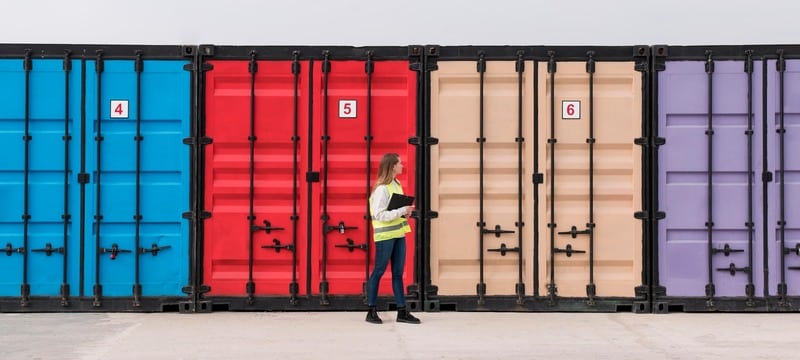Getting Started with Containers on the Cloud
Developers

Would you like a way to neatly run your applications seamlessly across different computing environments—and transport them from your local machine to the cloud, and everywhere in between? If so, you’re going to need a container.
What is a Container?
Containers provide a lightweight, efficient, and consistent application environment. These portable and self-sufficient containers can be run on a wide variety of platforms, making them ideal for building cloud-native apps, scaling microservices separately, or migrating projects across complex IT landscapes.
At its core, a container is a standardized unit of software that packages up code and all its dependencies. Once an application is stored in a container, it can be moved to another server, or even a local computer, with the expectation that it will function exactly the same. Just like in the shipping industry, goods are shipped in standardized containers, making them easier to load, unload, store, and transport.
The compact and lean nature of containers enables deployment across bare metal systems, public or private clouds, hybrid environments, and even spanning multiple clouds. It’s also common to run your container on a virtual machine. Because containers are typically measured by the megabyte and don’t need hypervisor software, they are generally considered a faster, more agile way of handling process isolation.
Why Should I Use Containers?
So what can containers do for you? Whether you’re developing or deploying applications or provisioning networks or servers, here are some of the reasons containers can make your life easier:
1. Efficiency: Containers are lightweight because they share the host system’s kernel, instead of requiring an entire operating system for each instance. This means containers use fewer resources and start up faster, resulting in significant performance improvements and cost savings.
2. Portability: Containers encapsulate an application and its dependencies into a single package, ensuring consistent behavior across different environments. Whether you’re developing on your laptop, testing on a server, or deploying in the cloud, the application behaves the same, reducing the friction of moving applications across various development and deployment stages.
3. Isolation: Containers provide a high level of isolation, ensuring that applications do not interfere with each other. This isolation enhances security and stability, allowing you to run multiple applications on the same infrastructure without the risk of conflicts.
4. Scalability: Containers can be quickly scaled up or down to meet varying demands. This elasticity is crucial for handling traffic spikes and optimizing resource use, making it easier to respond to changes in user demand without significant overhead.
5. Consistency: Containers ensure that an application will run the same, regardless of where it is deployed. This consistency is critical to avoiding the “it works on my machine” problem, streamlining the development process, and reducing debugging time.
While containers themselves package your application and its dependencies, a container engine like Docker provides the essential capabilities so you can manage your containers’ lifecycles effectively. Here’s why Docker (or a similar container engine) is crucial for working with containers:
The Role of Docker in Containerization
Docker, the most popular container engine, has made it easy to use containers by automating setups with a powerful command line and API. This free, open-source tool provides a platform that lets you build and manage containerized apps in record time. Here are some can’t-miss features of Docker, and the best ways to incorporate it into your container routine.
Key Features of Docker
Docker uses images, which are lightweight, standalone, and executable software packages that include everything needed to run a piece of software, including code, runtime, libraries, and settings. These images can be stored and shared via Docker Hub, a public registry.
Docker also allows you to create, start, stop, move, and delete containers using simple commands. This management is crucial for maintaining the lifecycle of containerized applications.
Docker provides built-in networking capabilities, enabling containers to communicate seamlessly with each other and the outside world.
Docker supports various storage options, allowing data persistence beyond the life of a container. This ensures that data is not lost when containers are stopped or removed.
Best Practices for Using Docker
To harness the full potential of Docker, it’s essential to follow best practices:
1. Use Minimal Base Images: Start with lightweight base images to reduce the attack surface and improve performance. Alpine Linux is a popular choice for its minimal footprint.
2. Keep Containers Immutable: Treat containers as immutable. Instead of updating a running container, build a new image with the required changes and redeploy. This ensures consistency and reliability.
3. Minimize the Number of Layers: Each instruction in a Dockerfile creates a layer in the image. Minimize the number of layers to keep images lean and efficient. This practice also reduces the potential for security vulnerabilities.
4. Limit Container Privileges: Run containers with the least privileges necessary. Avoid running containers as the root user to mitigate security risks and ensure a secure runtime environment.
5. Use Multi-Stage Builds: Multi-stage builds allow you to use multiple FROM statements in a Dockerfile, creating intermediate images that reduce the final image size. This technique helps in creating optimized, smaller images.
6. Regularly Scan for Vulnerabilities: Use tools like Clair or Trivy to scan container images for known vulnerabilities and apply updates promptly. Keeping images up-to-date ensures that your applications are secure.
7. Monitor and Log: Implement monitoring and logging to gain insights into container performance and issues. Tools like Prometheus and ELK Stack are popular choices that provide comprehensive monitoring and logging solutions.
Taming the Container Chaos: Introducing Orchestration Platforms
As you scale your containerized applications, managing individual containers manually becomes impractical. This is where container orchestration platforms like Kubernetes come into play.
What is Kubernetes?
Kubernetes, often abbreviated as K8s, is an open-source container orchestration platform that automates many manual processes in deploying, managing, and scaling containerized applications. While Docker handles the creation and management of containers, Kubernetes ensures that these containers run smoothly in production environments by providing:
Resource Management: Kubernetes optimizes resource usage by automatically scheduling containers based on resource requirements and constraints. This ensures efficient use of available resources.
Scaling: Kubernetes can automatically scale applications up or down based on demand. This elasticity is crucial for maintaining performance and optimizing costs.
Load Balancing: Kubernetes provides built-in load balancing, distributing traffic evenly across containers. This ensures high application availability and reliability.
Self-Healing: Kubernetes can automatically restart failed containers, replace containers, and reschedule them when nodes die, ensuring high availability and resilience.
Conclusion
Think of containers as self-contained computing environments – everything your app needs to run perfectly, packed neatly in a box. Building your application as a collection of tightly packaged containers allows you to build them in parallel with strict interfaces, so you can improve implementations without breaking running code.
Following best practices ensures your containerized apps are secure against attacks, lightning-fast performers, and easy to maintain for long-term success. While Docker provides a robust platform for managing containers, orchestrating them with tools like Kubernetes becomes essential as you scale. Embracing these technologies improves your workflow and ensures that your applications can meet the demands of modern users and dynamic environments.


